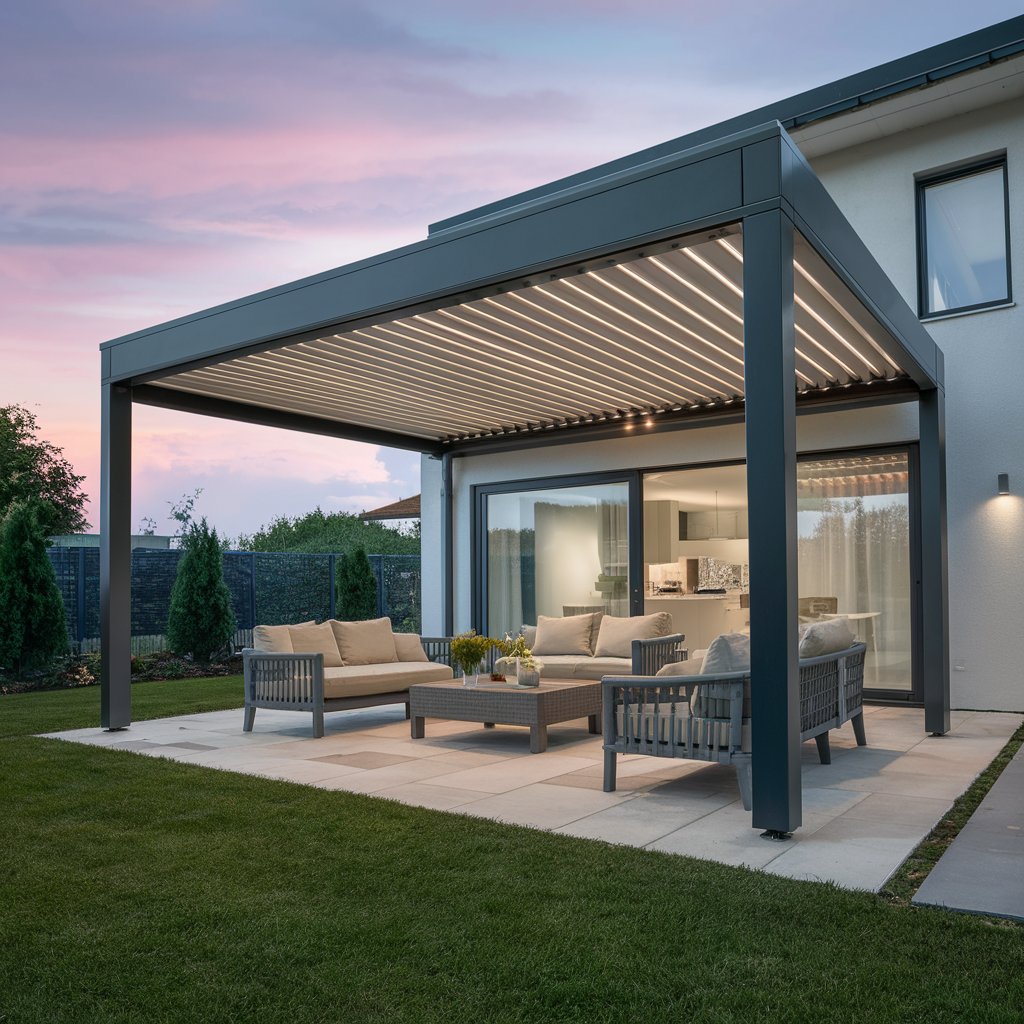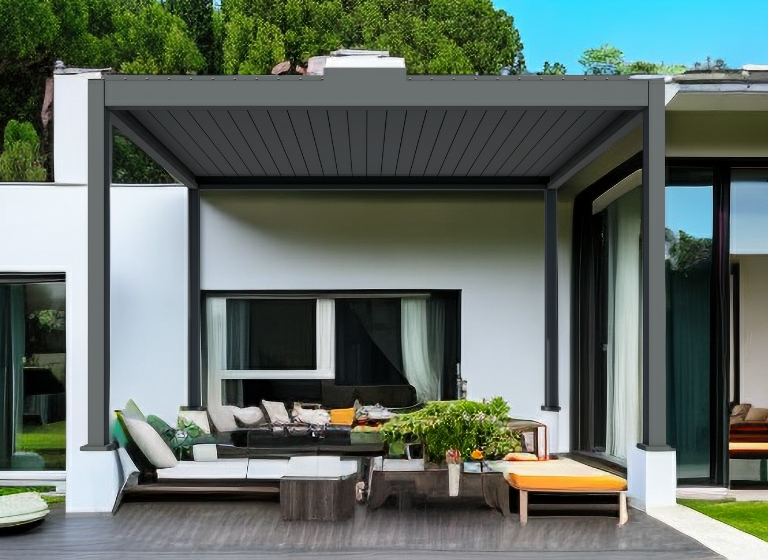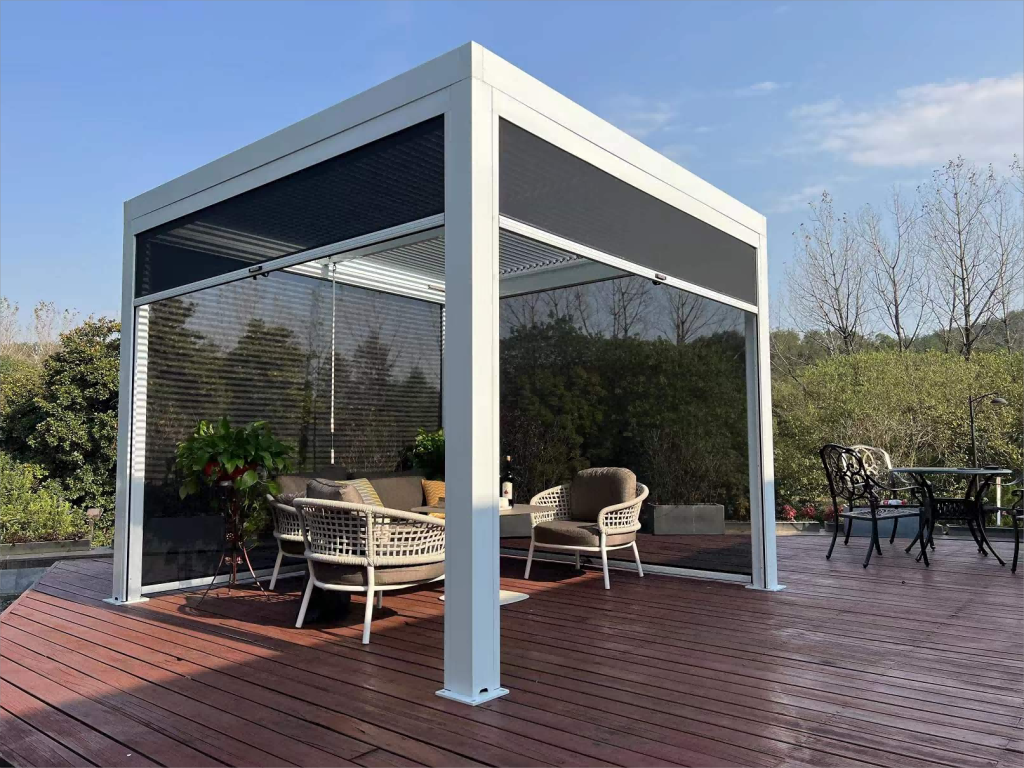Introduction
A patio cover is an essential addition to any outdoor living space, offering both practical and aesthetic benefits. It provides shade and shelter, extends the usability of your patio in various weather conditions, and can significantly enhance the overall appeal of your home. In this comprehensive guide, we will explore everything you need to know about patio covers, from the different types available to the benefits they offer, design considerations, materials, installation processes, and maintenance tips.
Types of Patio Covers

1. Pergolas
Pergolas are popular patio covers that feature an open, lattice-like design. They are typically made from wood, metal, or vinyl and can be freestanding or attached to the house. Pergolas provide partial shade and are often used to support climbing plants, creating a natural, green canopy.
Advantages:
- Aesthetic appealVersatility in designSupports plant growth
Disadvantages
- Limited protection from rainRequires regular maintenance (especially wood)
2. Awnings
Awnings are flexible, retractable patio covers made from fabric or other materials. They can be extended or retracted as needed, providing adjustable shade and protection.
Advantages:
- Retractable for adjustable use
- Variety of styles and colors
- Can be motorized for ease of use
Disadvantages:
- Limited lifespan of fabric
- Can be affected by strong winds
3. Solid Patio Covers
Solid patio covers are typically made from wood, aluminum, or vinyl and provide complete protection from sun and rain. They can be designed to match the architectural style of your home.
Advantages:
- Full protection from elements
- Durable and long-lasting
- Can be customized
Disadvantages:
- Higher cost
- Can block natural light
4. Gazebos
Gazebos are freestanding patio covers with a solid roof and open sides. They provide a shaded area and can be placed anywhere in the yard, not just over the patio.
Advantages:
- Freestanding design
- Aesthetic and functional
- Offers 360-degree views
Disadvantages:
- Higher cost
- Requires significant space
5. Shade Sails
Shade sails are patio covers made from durable, weather-resistant fabric stretched between anchor points. They provide shade with a modern, minimalist look.
Advantages:
- Modern design
- Affordable
- Easy to install
Disadvantages:
- Limited protection from rain
- Can be affected by strong winds
Benefits of Patio Covers
1. Protection from the Elements
One of the primary benefits of patio covers is the protection they offer from the sun, rain, and other weather conditions. This makes your outdoor space more usable year-round, allowing you to enjoy it even in less-than-ideal weather.
2. Extended Living Space
A patio cover effectively extends your indoor living space to the outdoors. This can be particularly beneficial for hosting gatherings, dining, or simply relaxing outside while still enjoying the comforts of home.
3. Enhanced Aesthetic Appeal
A well-designed patio cover can significantly enhance the aesthetic appeal of your home. It can be tailored to match your home’s architectural style and personal taste, adding a touch of elegance and sophistication to your outdoor space.
4. Increased Property Value
Investing in a patio cover can increase the value of your property. Prospective buyers often appreciate the added outdoor living space and the protection from the elements, making your home more attractive on the market.
5. Energy Efficiency
Patio covers can contribute to the energy efficiency of your home by providing shade and reducing the amount of direct sunlight that enters your home. This can help lower cooling costs during hot summer months.
Design Considerations
1. Purpose and Function
Before selecting a patio cover, consider its primary purpose. Are you looking for shade, rain protection, or an aesthetic feature? Understanding your needs will help you choose the right type of cover.
2. Architectural Style
The design of your patio cover should complement the architectural style of your home. Whether you have a modern, contemporary, or traditional home, there are patio cover designs that can enhance its overall look.
3. Size and Scale
The size and scale of your patio cover should be proportional to your outdoor space. A cover that is too large can overwhelm the area, while one that is too small may not provide adequate protection or aesthetic value.
4. Materials
Choosing the right material for your patio cover is crucial for its longevity and maintenance. Common materials for patio covers include wood, aluminum, and vinyl, each with its own set of benefits and drawbacks.
Wood:
- Natural and classic look
- Requires regular maintenance
- Can be customized
Aluminum:
- Durable and low maintenance
- Can be designed to mimic wood
- Lightweight and rust-resistant
Vinyl:
- Affordable and low maintenance
- Resistant to weather and insects
- Available in various colors and styles
5. Budget
Your budget will play a significant role in the type and design of your patio cover. It’s important to balance cost with quality to ensure you get a patio cover that meets your needs and lasts for years to come.
Installation Process
1. Planning and Design
The first step in installing a patio cover is planning and design. This involves measuring the space, selecting the type of cover, and creating a design that complements your home. You may need to consult with a professional to ensure the design is feasible and meets local building codes.
2. Obtaining Permits
Depending on your location, you may need to obtain permits before installing a patio cover. Check with your local building department to determine the requirements and ensure all necessary permits are acquired.
3. Preparing the Site
Prepare the site by clearing any obstacles and ensuring the ground is level. If you are installing a freestanding structure, you may need to pour concrete footings to provide a stable foundation.
4. Installation
The installation process will vary depending on the type of patio cover. For example, pergolas may require assembling the frame and attaching it to the house, while awnings may involve mounting brackets and securing the fabric. It’s important to follow the manufacturer’s instructions or hire a professional for proper installation.
5. Finishing Touches
Once the patio cover is installed, add finishing touches such as lighting, furniture, and decorative elements to create a comfortable and inviting outdoor space.
Maintenance Tips
1. Regular Cleaning
Regularly clean your patio cover to prevent dirt, debris, and mold buildup. Use a mild detergent and water to clean the surface, and avoid using harsh chemicals that can damage the material.
2. Inspect for Damage
Periodically inspect your patio cover for any signs of damage, such as cracks, rust, or loose fittings. Address any issues promptly to prevent further damage and ensure the cover remains in good condition.
3. Maintain Plants
If you have climbing plants growing on a pergola or other type of patio cover, ensure they are properly maintained. Trim the plants regularly to prevent overgrowth and check for any damage to the structure.
4. Apply Protective Coatings
For wood patio covers, apply a protective coating or sealant to prevent moisture damage and extend the life of the wood. Aluminum and vinyl patio covers may also benefit from a protective coating to maintain their appearance and durability.
5. Store Retractable Covers
If you have a retractable awning, store it properly during extreme weather conditions or when not in use for extended periods. This will help prolong its lifespan and keep it in good working condition.
Conclusion
A patio cover is a valuable addition to any home, offering protection from the elements, enhancing the aesthetic appeal, and increasing the usability of your outdoor space. By understanding the different types of patio covers, their benefits, design considerations, and maintenance requirements, you can make an informed decision that meets your needs and enhances your outdoor living experience. Whether you opt for a pergola, awning, solid cover, gazebo, or shade sail, investing in a patio cover is a step towards creating a comfortable and inviting outdoor sanctuary.
With the right patio cover, you can transform your outdoor space into a versatile, year-round retreat. Whether you’re hosting a summer barbecue, enjoying a quiet morning coffee, or seeking shelter from a sudden rain shower, a patio cover ensures that your outdoor area is always ready for use. By considering factors such as purpose, architectural style, materials, and budget, you can choose a patio cover that not only meets your practical needs but also enhances the beauty and value of your home.
In summary, patio covers are a wise investment for homeowners looking to maximize their outdoor living spaces. They provide essential protection from the elements, create additional living areas, boost property value, and contribute to energy efficiency. With various types of patio covers available, from pergolas and awnings to solid covers and gazebos, there is a solution to suit every style and need. By following proper installation and maintenance practices, you can enjoy the benefits of your patio cover for many years to come.



I like this web blog it’s a master piece! Glad I detected this ohttps://69v.topn google.Blog monry